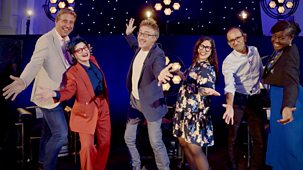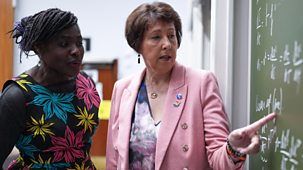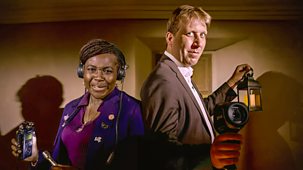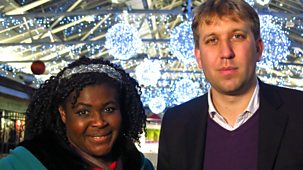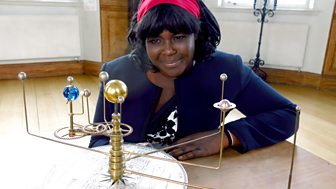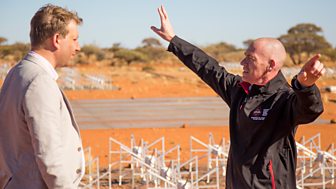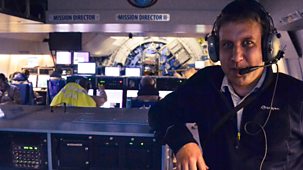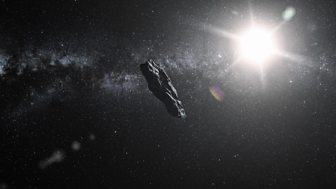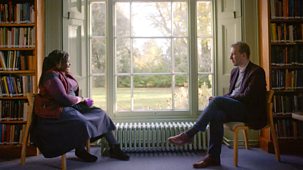
Exoplanets and Antarctica
In a month when the tally of confirmed exoplanets passed 5,000, it’s astonishing to remember that just 30 years ago, the notion of planets outside our own solar system was, well – just a notion. Since the first extrasolar planet was discovered in 1992, a staggering array of other worlds have been identified, including many in solar systems quite unlike our own. \n\nProfessor Amaury Triaud (University of Birmingham) studies binary systems - two stars locked in mutual orbit - and the planets that have been found orbiting them. Recently, Professor Triaud was the lead author on a paper describing how we might find many more planets in these solar systems with two suns – places often compared to Star Wars’ planet Tatooine.\n\nMost exoplanets have been discovered using the transit method, where a dip in a star’s luminance is recorded as a planet is observed ‘in transit’, ie passing across the star’s face. Thousands of transits have been observed using Nasa’s Keppler space telescope – the exoplanet discovery equivalent of a fishing trawler, hoovering up its quarry on an industrial scale. But while the transit method is an excellent way of discovering exoplanets, it comes with a serious drawback: the transit must be observed. In other words, the orbit of the planet, its star and the observing telescope must all be aligned in just the right place at just the right time. And in the three-dimensional vastness of space, that comes down to luck.\n\nIn binary systems, this eventuality requires even more good fortune. So, Professor Triaud and his team have been using a detection method known as the radial velocity technique. Trickier to pull off, but not reliant on happenstance. The premise of the radial velocity method is that orbiting systems are held together by gravity and will affect each other’s orbits. While a planet is held in place by its star’s gravitational field, the planet’s gravity in turn will also pull at the star, causing its path to deviate. This deviation is tiny, but critically it is measurable. The careful analysis of the degree to which a star ‘wobbles’ will tell you all about its orbiting planets. \n\nFor the first time, Professor Triaud has shown that this effect can be measured in complex binary systems using telescopes on Earth. It’s an exciting development. Many more new worlds can be discovered without the need for costly space telescopes and the luck of being aligned ‘just so’ to catch a transit. \n\nThe hunt for exoplanets is a major scientific endeavour, not only because it might provide answers to the question of life emerging in other parts of the universe, but also because it also gives us clues as to how planet formation occurs and solar systems emerge. However, it is a high precision game, and the locations for the specialist kit required are rarely the most hospitable.\n\nProfessor Triaud’s PhD student Georgina (‘George’) Dransfield recently travelled to Antarctica to work on upgrading the exoplanet hunting telescope Astep at the French Antarctic base, Concordia. George filmed the trip for us and explained to Maggie (who also has experience building telescopes in extreme locations) what the trip involved. Concordia sits 3,200m above sea level, where the atmosphere is dry and thin, making it as near to having a space telescope on Earth as possible. This, combined with the Antarctic winter giving three months of uninterrupted night sky, means it’s a no brainer as a location for a research telescope. Except, of course, its location is one of the most extreme on Earth! George and the team were there to move the telescope to a better, bigger dome, and upgrade its camera to a two-colour receiver rather than the original ‘black-and-white’ version. George was also responsible for designing and installing more advanced data handling techniques for the image-processing system.\n\nAll this would be hard enough at the best of times, but the Antarctic climate makes things a lot more challenging. ‘As soon as you step outside, the inside of your nose ices up,’ remembers George, ‘and you know, it sounds ridiculous, but I just wasn’t expecting how cold it would be!’\n\nBack in Birmingham, George is now using the uprated system in her PhD work, and is even nostalgic for Antarctica. ‘If you’d asked me at the time if I wanted to go back, I’d have probably said no,’ she confides, ‘but now, yeah, I’d definitely go back if I had the chance again!’ And if she doesn’t get that chance, there’ll be a permanent reminder of the trip – in the form of a new tattoo!\n\nAlso, in an update to last year’s programme about Jupiter, Jonny Nichols (University of Leicester) tells us how the mystery of the gas giant’s aurora has nearly been solved. ‘When I saw the data come in, I nearly fell off my chair,’ he tells Maggie. And, following a lockdown boom in telescope sales, viewer Stacey Downton from Longbridge shows us her telescopes and explains her passion for astrophotography.
Source: BBC 4
Most recent episodes of The Sky at Night
The Sky At Night
Asteroid Strike?
The team explore one of the biggest stories in space news, the ‘city killer’ asteroid 2024 YR4. First observed on 27 December 2024, it soon became one of the biggest ...
17-04-2025
BBC 4
The Sky At Night
Ancestral Skies
This month, The Sky at Night teams up with BBC Ideas to discover the secrets of archaeology and astronomy and to reflect on our ancestral skies. \n\nThroughout history and acros ...
14-11-2024
BBC 4
The Sky At Night
Question Time Special
Get ready for The Sky at Night’s annual Question Time Special, where viewers get the opportunity to ask the questions they have always wanted answered about our universe.\ ...
08-10-2024
BBC 4
The Sky At Night
2075: Our Place In Space
The Sky at Night is embarking on a journey into the future as we explore how space will revolutionise life on Earth over the next 50 years. As humanity's reach extends into the ...
11-09-2024
BBC 4
The Sky At Night
Nicky, Nasa And The Next Frontier
In this Sky at Night special, the team talk to Dr Nicola Fox, NASA’s head of science, whose life began in the UK.\n\nPresenter Chris Lintott chats to Nicky about her early ...
15-08-2024
BBC 4
The Sky At Night
Webb Telescope: The Story So Far
In July 2022, the James Webb Space Telescope released its first images. They were visually stunning, and it was clear they provided more detail of stars, galaxies and planets th ...
11-07-2024
BBC 4
The Sky At Night
Cosmic Ghosts
This month, The Sky at Night has a spooky twist. Across the universe, there are hidden objects that we can’t see, but astronomers and scientists still believe they’r ...
13-06-2024
BBC 4
The Sky At Night
Hiding In Starlight
Total solar eclipses, like the one seen last month in North America, allow us to see details of the Sun that can’t be seen at any other time. So, this month, The Sky at Ni ...
16-05-2024
BBC 4
The Sky At Night
Space Rock Return
The Sky at Night is back for a brand new series, and this month it is delving into Nasa’s OSIRIS-REx mission, which last year brought back a sample from the near-Earth ast ...
11-04-2024
BBC 4
Most popular episodes of The Sky at Night
The Sky At Night
Asteroid Strike?
The team explore one of the biggest stories in space news, the ‘city killer’ asteroid 2024 YR4. First observed on 27 December 2024, it soon became one of the biggest ...
17-04-2025
BBC 4
The Sky At Night
The Sky At Day
The British weather is often the enemy of stargazers up and down the country. A forecast of a couple of hours of cloud cover will disappoint even the most determined amateur ast ...
13-07-2022
BBC 4
The Sky At Night
Outback Astronomy
In February 2018, news broke that astronomers had seen the cosmic dawn - the moment when stars first formed, flooding the universe with light. What's remarkable is that this inc ...
12-07-2018
BBC 4
The Sky At Night
Webb Telescope: The Story So Far
In July 2022, the James Webb Space Telescope released its first images. They were visually stunning, and it was clear they provided more detail of stars, galaxies and planets th ...
11-07-2024
BBC 4
The Sky At Night
Telescope On A Plane!
Telescope on a Plane!\n\nIn this special programme, the Sky at Night takes to the air on board the largest airborne observatory in the world – a specially modified jumbo j ...
09-12-2018
BBC 4
The Sky At Night
Space Rock Return
The Sky at Night is back for a brand new series, and this month it is delving into Nasa’s OSIRIS-REx mission, which last year brought back a sample from the near-Earth ast ...
11-04-2024
BBC 4
The Sky At Night
The Mystery Of 'oumuamua
In October 2017, astronomers made a spectacular discovery - they spotted the first ever object to visit our solar system from outer space. They gave it a suitably exotic name... ...
15-02-2018
BBC 4
The Sky At Night
Pick Of The Year
Maggie Aderin-Pocock and Chris Lintott look back at some of the biggest stories featured on the programme in 2020, with the help of special guests who have chosen their favourit ...
20-01-2021
BBC 4
The Sky At Night
Review Of The Year
Chris and Maggie look back at some of the stories they have covered in 2021 in the Sky at Night’s big review of the year.\n\nIn February, three missions arrived at Mars. A ...
16-12-2021
BBC 4




